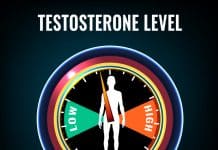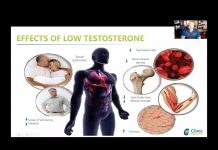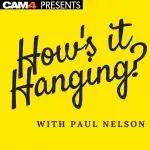There are many benefits of exercise . Beside the evident improved self-image, energy levels, and mental outlook, several research studies have found the following clinical benefits in body composition and metabolism: 1- Produces improved muscle function, increased body dimensions and mass, and strength when used alone. 2- May also reduce trunk (belly) fat mass 3- Increases muscle mass and decreases LDL when combined with testosterone in eugonadal men (men with normal testosterone) 4- Increases lean tissue accrual and strength gain 5- Resistance exercise training-induced muscle hypertrophy may promote triglyceride clearance
6- Exercise showed significant improvement in mood and overall distress
9- Exercise can increase bone density in men and women.
10- Testosterone and resistance exercise promote gains in body weight, muscle mass, muscle strength, and lean body mass
11- Exercise training resulted in a substantial improvement in aerobic function while immune indices were essentially unchanged.
Things to Consider :
1- Before you start. Get your blood pressure, heart rate, weight, body dimensions, fasting cholesterol, triglycerides and blood sugar measured before you start an exercise program. Your doctor should be able to advise you if you are capable of exercising without health problems. Check these variables monthly if you can. 2- If you are tired. If tired and weak, start walking every day to your best abilities. Walking can help increase energy levels to start a more intensive exercise program later on when you are feeling better. Using a cheap pedometer to measure your daily steps is useful. Trying to reach 10,000 steps a day has been associated with good cardiovascular health and fat loss.
3- Cardiovascular/aerobics. Do low to no impact aerobic exercise three to four times a week. Exercising for 20-40 minutes in a stationary bike, elliptical trainer, or trademill will increase your aerobic capacity, help to burn fat, and decrease cholesterol, triglycerides and blood sugar. Do not do aerobic exercise if you are losing weight involuntarily or if you are tired or recovering from illness. Some people worry that cardiovascular (aerobic) exercise can increase fat wasting (lipoatrophy) but this fear is a speculation in our opinion.
4- Weight Training (Resistance Exercise) Weight train with weights and machines three times a week for one hour. Starting with machines is the safest way until you get familiar with the exercises. As you get more confident and stronger, bring in free weight exercise (hopefully with the help of a workout buddy). Working out for more than an hour can cause over-training that can destroy your muscles and decrease your strength. Warm up before you workout and stretch afterwards to prevent injury. A light carbohydrate meal (fruits, carbohydrate drinks, etc) before a workout and a protein rich one afterwards is advisable. Keep yourself hydrated well with plenty of water throughout the workout. As you get stronger, increase your weights in every exercise. Exercise one body part per week, and three exercises per body part. Three sets per exercise and eight to ten repetitions per set (to momentary muscular failure- meaning until you can not do another rep) are enough. Eat a good healthy and balanced meal with protein, vegetables and fruit after a work out. Get plenty of rest.
Other Important Things to Consider:
· Learn how to do each exercise correctly and concentrate on using strict form.
· Make sure your muscles are warm before targeting them with more challenging weights
· Don’t use momentum; use a deliberate speed of movement to increase the effectiveness of the movement. Cheating this way takes work away from the targeted muscles.
· Use a full range of motion on all exercises. Feel the muscle stretch at the bottom and go for a momentary peak contraction at the top.
· Feel the muscle working by keeping your head into what you’re doing. Focus on your muscles contracting and relaxing. Concentrate on your body on exercise, not on thoughts and people around you.
· Briefly stretch the major muscle groups before your training. This helps flexibility and muscle recovery.
· If the weight’s too light (more than 12 repetitions), try using a heavier resistance or doing the movement more slowly and really feel the contraction.
· Keep rest periods to no more than about 20-3- seconds, or shorter, depending on how tired you are from your last set. This will also help to give your heart a mini-workout.
Safety First!
Always remember – safety first. If something you do in an exercise hurts, stop! Ask for help to figure out what you are doing that’s wrong. Maybe it’s improper form. If you hurt yourself you will hinder your progress because you won’t be about to work out! Learn proper form!Commit Yourself
First thing is to join a gym if you can afford it. If you spend the money, you’ll be more likely to stay with it, and consistency is the key to success in any exercise program. Also, try to find someone who is enthusiastic to train with, or get a personal trainer (if you can afford one). It’s easier to stay motivated when you train with someone else who has a vital interest in your mutual success. It’s also safer to have someone to spot you when you lift heavy weight.Do Not Overtrain!
Overtraining is probably the most ignored factor by exercise enthusiasts. In order to build muscle, the body has to receive a stimulus ‑‑ a reason ‑‑ to grow bigger, or hypertrophy. It’s really very simple: the body only does what it needs to do ‑‑ what it is required to do. It isn’t going to suddenly expand its muscle mass because it anticipates needing more muscles. But if it is challenged to move weights around, it will respond by growing. Another way to look at it is if you take ANY body*builder and put him in bed for weeks at a time, he’ll begin to rapidly lose muscle mass ‑‑ because the body will sense it doesn’t need the extra muscle any more! So, one needs to deliver the STIMULUS to stimulate muscular hypertrophy (growth) in the body ‑‑ and that’s what lifting weights does. BUT –overdoing that, overtraining, overstresses the body and initiates the process of actually breaking down muscle mass as the body begins to burn its own muscles to use for fuel! This is why so many people don’t grow at a satisfying rate.
Even worse, often times these people will think they aren’t training hard enough, and INCREASE their exercise routines thinking they just need MORE stimuli! And this is where the biggest error is made — more is NOT necessarily better! It seems paradoxical that you could work out LESS and grow MORE, but this is VERY OFTEN the case.
Therefore, ANY EXERCISE beyond that which is the exact amount of stimulus necessary to induce optimal muscle growth is called OVERTRAINING. Let’s repeat that again: EXERCISING MORE than what the body requires to stimulate it maximally to grow is OVERTRAINING.
Recommended – A Workout Log
The best reason to keep track of your workouts is so that you can see graphically what you are accomplishing, and analyze your pattern to see if you’re overtraining. That is, you program your mind when you look at black and white and you will also be able to see whether you’re graining at a reasonable rate. You will find that if you log your workouts, if you are overtraining, you won’t be gaining in strength, and this adds up to not gaining in muscle size. So document your workouts by keeping track of the weight you lift and the amount of reps you lift for each exercise, and then when you go in to train again the next week, you know what you are trying to better. If you find out that you’re weaker than you were the time before, and everything else like nutrition, etc. are in line, you may be training too oftenFood and Hydration
1- Drink at least 8 glasses of water a day to keep hydrated. Dehydration can rob you on energy for your workouts. Drink plenty of water while working out and avoid drinking drinks containing sugars since they will cause fatigue after an initial raise in energy.
2- Do not work out after eating a regular meal. Wait at least two hours. If you need a snack, have some fruit and a slice of toast with peanut butter 1 hour or more before working out. Do not consume protein shakes before working out (leave it for after the work out). Digestion will slow down your workouts and bring your energy down.
3- Within 30 minutes to and hour after the work out, feed your muscles with a balance meal containing protein, good fats (olive oil, flaxseed oil), and complex carbohydrates like fruits and whole grains.
4- Supplements like glutamine,creatine and whey protein may be a good thing to consider. A shake containing 1 heaping tablespoon of glutamine, two tablespoons of flaxseed oil, one or two scoops of whey protein, milk (if you are not lactose intolerant, otherwise almond or rice milk- not soy since it has shown to increase estrogen in men), and fruit provides a good balance meal after a work out.
Resistance training for best results:
Starters: Once-A-Week training:
This section is for those who have only recently recovered from illness, or just getting into weight lifting for the first time. For the first few weeks, until your stamina is up, do only one workout per week. This workout is a whole-body workout program that looks like this:“Warm-up set” (wu) weight means a set where you use a weight that is about 50-60% of the heavy weight set that you use. “Heavy” (hvy) means a weight that you are only capable of lifting 6-12 times before complete muscular failure.
1. Barbell flat bench press – 2 wu and 1 hvy set
2. Curl-grip pulldowns – 2 wu and 1 hvy set
3. Squat or seated leg press – 2 wu and 1 hvy set. Squats are a “best” exercise, but some people have to substitute the leg press because their back won’t tolerate squats.Warm-up sets employ poundage that you know you can easily
handle for 12 repetitions (reps). Rest for about one minute between sets or longer – until you feel like you have enough energy to go again. Two warm up sets should be enough to warm all the joints involved without tiring you too much. Then do the heavy set. You want to lift the weight until you can’t lift it again. This is called “momentary muscular failure”.Important: It’s important to go to failure to trigger the muscles to grow, but challenge yourself to the best of your ability. Your level of intensity in the beginning won’t be as much as it can be later, after you’ve been at it for a while.
Do this workout on a day when you feel relatively good.
If you find that you feel exhausted during the beginning efforts, pace yourself more carefully and make sure your nutrition is good. You should be getting balanced nutrition (like food!) three to six times a day and be sure to get plenty of rest and recovery. Protein drinks can fill in between meals. (I.e. three meals with two or three drinks.) Continue with once-a-week workouts until you find that you feel good enough to workout on a second non-consecutive day of the week. Then do this same workout twice a week. When you feel good enough to workout three days a week, it’s time to start splitting the workout up to separate the body parts. You will also be starting to train your heavy sets with more intensity — so you’ll see an acceleration of the muscular gains.
THE THREE DAY SPLIT
Day #1 Chest, Shoulders, Triceps
Barbell flat bench press – 2 wu and 1 hvy set
Barbell military press – 2 wu and 1 hvy set
Triceps pushdowns – 2 wu and 1 hvy setDay 2: Back, Biceps, Abs
Curl grip pulldowns – 2 wu & 1 hvy set
Barbell biceps curl – 2 wu & 1 hvy set
Crunches – 3 sets of 10-20Day 3: Quadriceps, Hamstrings, and Calves (Legs)
Squat or leg press – 2 wu and 1 hvy set
Again, the squat is the better overall exercise, but some people cannot do it because of back problems, so they do the leg press.Lying leg curls – 2 wu and 2 hvy sets
Standing calf raises – 2 wu & 1 hvy setWorkout Log
Keep a record of your workouts and when you can lift a weight for 12 reps, raise the weight 5-10 lbs. so that you can only lift 6 reps. Then try to increase the number of reps you can lift each time you workout to arrive at 12 reps again, and repeat the progression so that you keep increasing the weight you lift. As you grow stronger, you will grow bigger muscles. You’ll probably be pretty sore during your recovery days. Let yourself heal so that the soreness goes away for best recovery and growth, even if this means you put several days between workouts.Keep in mind that the goal is to gain strength and lean body mass. Usually strength precedes size, so you get stronger and then notice that you’re getting more muscular.
Descriptions of the Exercises:
One of the best web sites that show video clips of exercises and explain anatomy is
https://www.exrx.net/Lists/Directory.htmlYou can also find most exercise routines explained in videos on youtube.com and manshealth.com

















